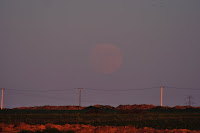Below is a link to a Star Phoenix article about
Leaf and Stone. The guys who own the company, Robert Fisher and Murray McArthur are two smart guys who I consider friends. We're working together on a project and I am excited to be a part of it. I've also included the text of the story, in case the link on the Star Phoenix site ever changes.
Firm hopes method resonates with mining industry"Firm hopes method resonates with mining industry Satellite-based data analysis touted for exploration
By Cassandra Kyle, The StarPhoenix - June 30, 2010
As the old saying goes, if something is too good to be true it usually is.
It's an adage Saskatoon businessperson Robert Fisher, CEO of Leaf and Stone Resonance Services Ltd. (L&S) is fighting against as he tries to spread the word about a new type of mineral exploration technology that uses satellite-based data analysis to locate Mother Nature's hidden resources.
"Give us a sample and we'll find the match -- it doesn't really matter what you're looking for," Fisher said in a recent interview.
"What we're really doing is we're taking a physics and a mathematical solution to a geological problem."
Using resonance coupling technology, a method developed by his Austin, Texas-based friend and business partner David Carr, the company surveys a client's property via satellite looking for a match to the sample substance provided. So far the technology, which is licensed to Carr's company Natural Resource Testing LLC, has found oil, gas, gold, diamonds and several other natural substances using the unique method.
Clients have been satisfied with the resonance coupling results, but it has been difficult for L&S, which acts as the marketing agent for the technology, to convince long-serving mining industry executives to give the technology a try.
"No one believes us. It's been our biggest issue," said Fisher, a longtime Saskatoon resident who used to work in the heath-care software industry.
"We say we have great credibility, but I'm sure to geologists and geophysicists we have none. . . . But it's just a matter of time -- 30 clients are now 40 and it's growing."
In a nondescript office in downtown Saskatoon, Fisher presents evidence of the technology's accuracy: Maps showing the resonance coupling picking up the gold vein between Red Lake and Madsen, Ont.; notes of thanks, including one praising the company for informing a client the actual location of its gold deposit was really 30 metres in the opposite direction and a letter of reference from an oil and gas company praising the veracity of the exploration method.
Resonance coupling, Fisher explained, isn't supposed to replace traditional mineral exploration methods. Based on the physics principle that every substance on earth has a unique resonance signal, the technology can focus in on where deposits are located, increasing accuracy and reducing needless drilling.
"Is saves you money, which is the big name in exploration," he said.
With the industry naturally skeptical of new technology -- especially one such as resonance coupling -- Fisher understands any acceptance of the unique exploration system will take time.
Still, with a sales office recently opening in Australia and the company recording its first repeat customer just last week, Fisher remains positive about the applications of the technology he believes is worth billions of dollars.
"I truly believe that is the battle; we need to just convert people," he said.
ckyle@sp.canwest.com
© Copyright (c) The StarPhoenix"





















































